Jug |
 |
 |
 |
 |
Oinochoe |
Oinochoe is a jug for pouring wine. This name is from
"oinos" means wine and "cheo" means
pouring. This name must be applied for this shape from
the literary evidence.
There are many varieties in oinochoe. "Olpe"
is the oldest and has a S shaped profile from the lip
to the foot. "Oinochoe type 1" has a trefoil mouth and a high vertical
handles and "Oinochoe type
2" has a lower handle. Type 3 is also called
"Chous" and has a squat
body. There are some many other shape from the type
4 to the type 10.
Oinochoe was produced from the beginning of the black-figure
to the end of the red-figure, though the preferred shape
is differed from the period.
figured scene is usually arranged on the paneled picture
on the body. |
 |
Olpe |
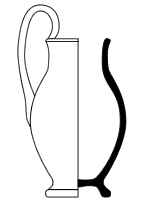
S shape profile from the flat lip to the foot and a
vertical handle. This shape is the oldest oinochoe in
the Attic black-figure and produced from the beginning
of it to the end of the sixth century though there is
no example painted by the red-figure. It was maybe developed
into the "Oinochoe type 5a" with thicker lip, since some late
olpe has a shape similar to the type 5.
The figured scene is arranged on the body as a paneled
picture. Cf. Missisipi1977.3.76 (Perseus
Project).
Dimensions: height 20cm |
 |
Oinochoe type 1 |
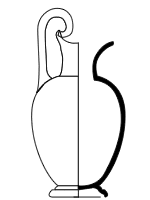
Oval body with a offset neck, a trefoil mouth and a
high handle. This shape was produced from the beginning
of the black-figure to slightly before the end of the
red-figure.
Normally, the ornament is only done on the body, though
there are some examples in black-figure with a decoration
on the neck. Some late oinochoe have a white ground
body. Since this shape has a origin in the bronze vessel,
a relief ornament of human head is attached on the connection
between the handle and the mouth. Red-figured oinochoe
usually has a panel on the body and sometimes a palmette
pattern on the connection. Cf. Harvard 1954.142 (Perseus
Project).
Dimensions: height 20-30cm |
 |
Oinochoe type 2 |
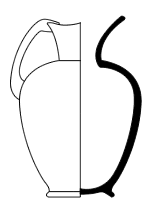
Oval body with a offset neck, a trefoil mouth and
a short handle. This shape was produced from about
530 B.C. to slightly before the end of the red-figure,
though preferred in the late fifth century. Cf. Harverd
1959.189 (Perseus
Project).
The way of the decoration is usually same as the type
1, also there are some jug with white ground.
Dimensions: height 20cm
|
 |
Chous |
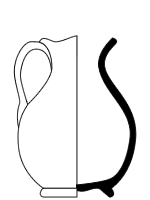
Bulbous body with continuous curve from the mouth to
the foot, a trefoil mouth and a low handle. The name
"Chous" is from the word "cheo"
means pouring, and used for the jug distributed to the
children who joined in "Anthesteria" festival,
which celebrate the harvest of wine.
The jug with the black-figure is called type 3 and produced
after the middle of the sixth century. Chous was preferred
after the middle of the fifth century. Some of them
are smaller than 10cm and probably used as a offering
for the tomb of a child.
The figured scene is arranged on the body as a panel
picture and some chous have figures of children. Cf.
Rhode
25.067 (Perseus
Project).
Dimensions: height 20cm, though some example maybe used
for funeral is smaller than 10cm.
|
 |
Oinochoe type 4 |
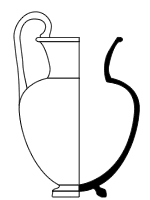
Bulbous body with a offset neck, a round mouth and
a high handle. There is no example with black-figure,
except a few similar to this. Red-figured jug was
introduced in the second quarter of the fifth century,
although there are not so many number. Cf. Boston
13.197 (Perseus
Project).
Figured scene is usually simple and decoration is
used as a frame of the picture.
Dimensions: height 20cm
|
 |
Oinochoe type 5A |
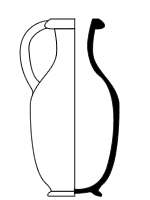
Slender body with shoulder slightly set off from
body, a round mouth and a short handle.
There is no example with the black-figure, although
olpe is similar to the shape. This jar was introduced
in the early year of the red-figure, although only
a few example is left. Cf. Yale
1913.143 (Perseus
Project).
The ornament was preferred and sometimes arranged
on the mouth and the handle. Figured scene is arranged
on the body and often on the neck.
Dimensions: height 30cm
|
 |
Oinochoe type 5B |
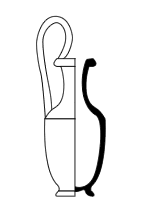
Slender body with a shoulder slightly set off from
the body, a round mouth and a high handle.
There is no example with the black-figure and red-figured
one is produced from the end of the sixth century
to the early fifth century and only a few example
is left.
Dimensions: height 30cm
|
 |
Oinochoe type 6 |
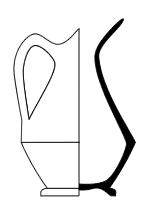
long spout and vertical handle. There is no black-figure
example and it was introduced in the red-figure about
the end of the sixth century. It was produced till
the middle of the fifth century, though only a dozen
jar is left.
There is less ornament and figured scene is arranged
on the upper part of the body.
Dimensions: height 10-20cm
|
 |
Oinochoe type 7 |
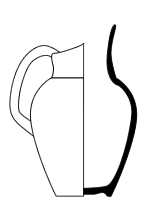
Oval body with a offset neck, a spout extended upward
and a handle.
Few example with black-figure is left and red-figure
example was produced in the first half of the fifth
century. Cf. Raleigh
G.79.11.5 (Perseus
Project).
The decoration became ornate later and the figured
scene is arranged on the body and sometimes on the
neck, though sometimes the scaled pattern is arranged.
Dimensions: height 20cm
|
 |
Oinochoe
type 8A or Mug A
|
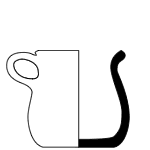
Short body and a vertical handle. This shape is most
preferred in the mug.
All the mug is decorated by the red-figure and produced
from the end of the sixth century to the fifth century.
The ornament is very simple and a figure or two is
arranged on the front of the body. Cf. Harvard 1960.352 (Perseus
Project).
Dimensions: height 10cm
|
 |
Oinochoe
type 8B or Mug B |
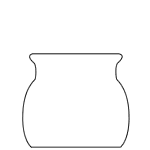
Short body without handle.
All the mug is decorated by the red-figure and produced
from the end of the sixth century to the fifth century.
The ornament is very simple and a figure or two is
arranged on the front of the body.
Dimensions: height 10cm
|
 |
Oinochoe
type 8C or Mug C |
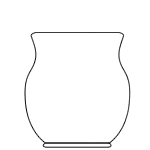
Tall body with a vertical handle.
All the mug is decorated by the red-figure and produced
from the end of the sixth century to the fifth century.
The ornament is very simple and a figure or two is
arranged on the front of the body.
Dimensions: height 10-15cm
|
 |
Oinochoe
type 9 |
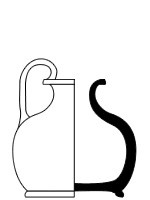
Squat body with round mouth and vertical handle.
All example is decorated by the red-figure and produced
in the middle of the fifth century. Cf. Berlin F2414 (Perseus
Project).
There is no ornament and only one or two figure is
are arranged.
Dimensions: height 20cm
|
 |
Oinochoe
type 10 |
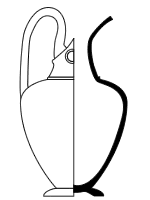
Oval body and offset neck with a long spout like
a beak and a high vertical handle. A circle ornament
is attached on the either side of the mouth. This
shape was probably derived from the bronze vessels.
Only few example with black-figure is known and a
dozen jug with red-figure is left.
Figured scene is arranged on the body and the ornament
is sometimes arranged as a upper and lower frame of
the picture.
Dimensions: height 20-30cm
|
 |
Kyathos |
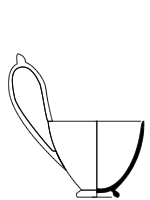
Ladle in the form of a cup with a short foot and
a long vertical handle with a shell like relief ornament
on top. The name "kyathos" was used for
the bronze ladle but it is not certain whether it
was applied for the pottery. This shape was derived
from the Bucchero pottery and have a origin in the
bronze vessel.
There are many example painted by the black-figure
and it was produced from the fourth quarter of the
sixth century. Eyes are usually arranged on the body
and sometimes a figure stand between the eyes. Rarely
it was painted by the red-figure. Cf. Harvard 1969.15 (Perseus
Project).
Dimensions: height 10-15cm
|
 |
Epichysis |
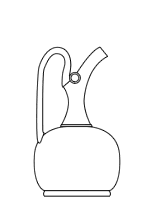
The jug, meaning "to pour", has squat body,
sometimes with rib decoration, tall and nallow neck
and beak spout. The handle similars to that of type
10. Most of the vases were produced in South Italy.
Cf. Wuerzburg (Martin
von Wagner Museum).
Dimensions: height about 10cm
|
 |
Lagynos |
|
 |
|
|
|